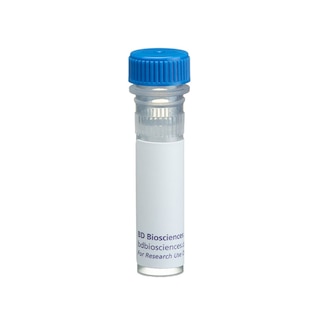-
Reagents
- Flow Cytometry Reagents
-
Western Blotting and Molecular Reagents
- Immunoassay Reagents
-
Single-Cell Multiomics Reagents
- BD® OMICS-Guard Sample Preservation Buffer
- BD® AbSeq Assay
- BD® Single-Cell Multiplexing Kit
- BD Rhapsody™ ATAC-Seq Assays
- BD Rhapsody™ Whole Transcriptome Analysis (WTA) Amplification Kit
- BD Rhapsody™ TCR/BCR Next Multiomic Assays
- BD Rhapsody™ Targeted mRNA Kits
- BD Rhapsody™ Accessory Kits
- BD® OMICS-One Protein Panels
-
Functional Assays
-
Microscopy and Imaging Reagents
-
Cell Preparation and Separation Reagents
Old Browser
This page has been recently translated and is available in French now.
Looks like you're visiting us from {countryName}.
Would you like to stay on the current location site or be switched to your location?
BD Transduction Laboratories™ Purified Mouse Anti-Hsp60
Clone 24/HSP60 (RUO)


Immunofluorescent staining of A549 (ATCC CCL-185) cells. Cells were seeded in a 96 well imaging plate (Cat. No. 353219) at ~ 10 000 cells per well. After overnight incubation, cells were stained using the Triton™ X-100 perm protocol and the anti-Hsp60 antibody. The second step reagent was Alexa Fluor 488 goat anti mouse Ig (Invitrogen). The image was taken on a BD Pathway™ 855 Bioimager using a 20x objective. This antibody also stained U-2 OS (ATCC HTB-96) and HeLa (ATCC CCL-2) cells using both the Triton™ X-100 and alcohol perm protocols (see Recommended Assay Procedure).



Western blot analysis of Hsp60 on a Jurkat lysate (Cat. No. 611451). Lane 1: 1:5000, lane 2: 1:10000, lane 3: 1:20000 dilution of the Hsp60 antibody.
Immunofluorescent staining of A549 (ATCC CCL-185) cells. Cells were seeded in a 96 well imaging plate (Cat. No. 353219) at ~ 10 000 cells per well. After overnight incubation, cells were stained using the Triton™ X-100 perm protocol and the anti-Hsp60 antibody. The second step reagent was Alexa Fluor 488 goat anti mouse Ig (Invitrogen). The image was taken on a BD Pathway™ 855 Bioimager using a 20x objective. This antibody also stained U-2 OS (ATCC HTB-96) and HeLa (ATCC CCL-2) cells using both the Triton™ X-100 and alcohol perm protocols (see Recommended Assay Procedure).

Western blot analysis of Hsp60 on a Jurkat lysate (Cat. No. 611451). Lane 1: 1:5000, lane 2: 1:10000, lane 3: 1:20000 dilution of the Hsp60 antibody.

Immunofluorescent staining of A549 (ATCC CCL-185) cells. Cells were seeded in a 96 well imaging plate (Cat. No. 353219) at ~ 10 000 cells per well. After overnight incubation, cells were stained using the Triton™ X-100 perm protocol and the anti-Hsp60 antibody. The second step reagent was Alexa Fluor 488 goat anti mouse Ig (Invitrogen). The image was taken on a BD Pathway™ 855 Bioimager using a 20x objective. This antibody also stained U-2 OS (ATCC HTB-96) and HeLa (ATCC CCL-2) cells using both the Triton™ X-100 and alcohol perm protocols (see Recommended Assay Procedure).




Regulatory Status Legend
Any use of products other than the permitted use without the express written authorization of Becton, Dickinson and Company is strictly prohibited.
Preparation And Storage
Recommended Assay Procedures
Bioimaging
1. Seed the cells in appropriate culture medium at ~10,000 cells per well in a BD Falcon™ 96-well Imaging Plate (Cat. No. 353219) and culture overnight.
2. Remove the culture medium from the wells, and fix the cells by adding 100 μl of BD Cytofix™ Fixation Buffer (Cat. No. 554655) to each well. Incubate for 10 minutes at room temperature (RT).
3. Remove the fixative from the wells, and permeabilize the cells using either BD Perm Buffer III, 90% methanol, or Triton™ X-100:
a. Add 100 μl of -20°C 90% methanol or Perm Buffer III (Cat. No. 558050) to each well and incubate for 5 minutes at RT.
OR
b. Add 100 μl of 0.1% Triton™ X-100 to each well and incubate for 5 minutes at RT.
4. Remove the permeabilization buffer, and wash the wells twice with 100 μl of 1× PBS.
5. Remove the PBS, and block the cells by adding 100 μl of BD Pharmingen™ Stain Buffer (FBS) (Cat. No. 554656) to each well. Incubate for 30 minutes at RT.
6. Remove the blocking buffer and add 50 μl of the optimally titrated primary antibody (diluted in Stain Buffer) to each well, and incubate for 1 hour at RT.
7. Remove the primary antibody, and wash the wells three times with 100 μl of 1× PBS.
8. Remove the PBS, and add the second step reagent at its optimally titrated concentration in 50 μl to each well, and incubate in the dark for 1 hour at RT.
9. Remove the second step reagent, and wash the wells three times with 100 μl of 1× PBS.
10. Remove the PBS, and counter-stain the nuclei by adding 200 μl per well of 2 μg/ml Hoechst 33342 (e.g., Sigma-Aldrich Cat. No. B2261) in 1× PBS to each well at least 15 minutes before imaging.
11. View and analyze the cells on an appropriate imaging instrument.
Bioimaging: For more detailed information please refer to http://www.bdbiosciences.com/support/resources/protocols/ceritifed_reagents.jsp
Western blot: For more detailed information please refer to http://www.bdbiosciences.com/pharmingen/protocols/Western_Blotting.shtml
Product Notices
- Since applications vary, each investigator should titrate the reagent to obtain optimal results.
- Please refer to www.bdbiosciences.com/us/s/resources for technical protocols.
- This antibody has been developed and certified for the bioimaging application. However, a routine bioimaging test is not performed on every lot. Researchers are encouraged to titrate the reagent for optimal performance.
- Caution: Sodium azide yields highly toxic hydrazoic acid under acidic conditions. Dilute azide compounds in running water before discarding to avoid accumulation of potentially explosive deposits in plumbing.
- Source of all serum proteins is from USDA inspected abattoirs located in the United States.
- Triton is a trademark of the Dow Chemical Company.
Companion Products






Heat shock proteins (Hsp) are a set of highly conserved proteins that include constitutively expressed (Hsp60, Hsp70, and Hsp90) and stress-induced (Hsp27 and Hsp72) proteins. Hsp60 is localized to the mitochondria, where it promotes mitochondrial protein folding and facilitates proteolytic degradation of misfolded or denatured proteins. It binds Hsp10, which regulates the substrate binding and ATPase activity of Hsp60. In HeLa and Jurkat mitochondria, Hsp60 associates with caspase-3 to form a complex that dissociates and releases from the mitochondria during apoptosis. In addition, Hsp60 accelerates the maturation of procaspase-3 through its ATP-dependent "foldase" activity. In addition to its role in protein folding, Hsp60 has also been implicated in immune function. In macrophages, its binding to the toll-like receptor-4 complex induces production of TNFα and nitric oxide and stimulation of a proinflammatory response. Thus, the protein folding function of Hsp60 is involved in mitochondrial protein folding in both normal and apoptotic cells, while release of Hsp60 during necrosis is thought to stimulate a proinflammatory response.
Development References (4)
-
Ohashi K, Burkart V, Flohe S, Kolb H. Cutting edge: heat shock protein 60 is a putative endogenous ligand of the toll-like receptor-4 complex. J Immunol. 2000; 164(2):558-561. (Biology). View Reference
-
Samali A, Cai J, Zhivotovsky B, Jones DP, Orrenius S. Presence of a pre-apoptotic complex of pro-caspase-3, Hsp60 and Hsp10 in the mitochondrial fraction of jurkat cells. EMBO J. 1999; 18(8):2040-2048. (Biology). View Reference
-
Venner TJ, Singh B, Gupta RS. Nucleotide sequences and novel structural features of human and Chinese hamster hsp60 (chaperonin) gene families. DNA Cell Biol. 1990; 9(8):545-552. (Biology). View Reference
-
Xanthoudakis S, Roy S, Rasper D, et al. Hsp60 accelerates the maturation of pro-caspase-3 by upstream activator proteases during apoptosis. EMBO J. 1999; 18(8):2049-2056. (Biology). View Reference
Please refer to Support Documents for Quality Certificates
Global - Refer to manufacturer's instructions for use and related User Manuals and Technical data sheets before using this products as described
Comparisons, where applicable, are made against older BD Technology, manual methods or are general performance claims. Comparisons are not made against non-BD technologies, unless otherwise noted.
For Research Use Only. Not for use in diagnostic or therapeutic procedures.